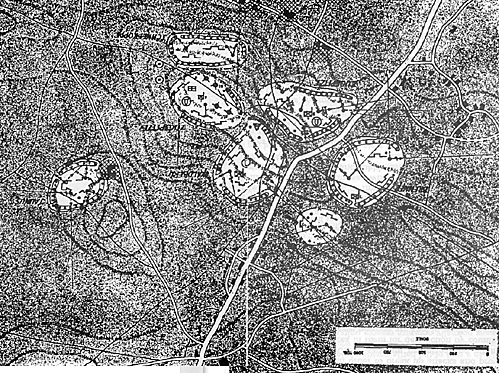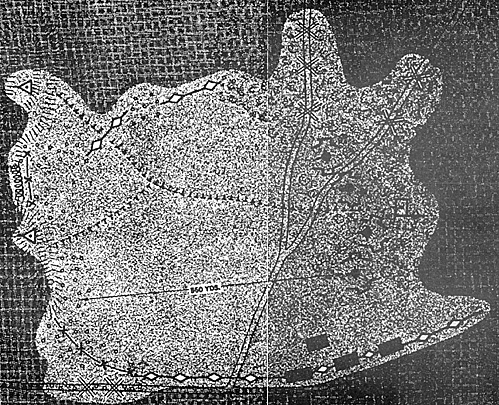 German defense of a position, whether hastily prepared or complete
in all details, is conducted on the same principles. Unless they are compelled
by manpower and materiel shortages to rely on the strength of their positions,
the Germans prefer heavy concentrations of fire and powerful, coordinated
counterattacks by mobile reserves of all arms. They apply the principle of
selecting a point of main effort (Schwerpunkt) to the defense as well as to the
attack. This principle necessarily is applied in reverse order in the defensive,
the main effort being made opposite the point where the enemy is making his
main attack.
German defense of a position, whether hastily prepared or complete
in all details, is conducted on the same principles. Unless they are compelled
by manpower and materiel shortages to rely on the strength of their positions,
the Germans prefer heavy concentrations of fire and powerful, coordinated
counterattacks by mobile reserves of all arms. They apply the principle of
selecting a point of main effort (Schwerpunkt) to the defense as well as to the
attack. This principle necessarily is applied in reverse order in the defensive,
the main effort being made opposite the point where the enemy is making his
main attack.
German artillery attempts to disrupt a hostile attack before it reaches the defensive positions. The Germans state that it is invaluable to install observation posts simultaneously in the main line of resistance, in the advanced position, and in the immediate vicinity of the gun position. Thus they try to keep a hostile force constantly under observation and fire even when it achieves a penetration. The artillery regiment commander controls the fire as long as possible, although requests for artillery barrages may be made by unit commanders as low as platoon leaders. Capabilities of German heavy mortars, which like all other support weapons usually are sited on reverse slopes, are exploited, with a present trend toward mortar-fire concentration.
When a part of the battle position is lost, the area is taken under artillery fire to annihilate enemy forces which have penetrated it. The Germans normally organize reserve units, even when only relatively few troops are available. Immediate local counterthrusts by infantry elements and support weapons near the penetration endeavor to hurl back the enemy before he has an opportunity to establish himself. These small counterthrusts, which normally closely follow the artillery fire, preferably are directed at the flanks of the penetrations.
 When the enemy succeeds in making a large penetration or
breakthrough, the German higher echelon commander decides whether a
general counterattack should be launched to restore the position or whether
the main battle position should be reestablished farther to the rear. The
counterattack is directed against the hostile flank, where possible, and is
prepared thoroughly. Assembly area, time, objective, zone, artillery support,
and employment of tanks, self-propelled artillery, assault guns, and air units
are controlled by one commander.
When the enemy succeeds in making a large penetration or
breakthrough, the German higher echelon commander decides whether a
general counterattack should be launched to restore the position or whether
the main battle position should be reestablished farther to the rear. The
counterattack is directed against the hostile flank, where possible, and is
prepared thoroughly. Assembly area, time, objective, zone, artillery support,
and employment of tanks, self-propelled artillery, assault guns, and air units
are controlled by one commander.
German antiaircraft defense, which is unable to give adequate protection everywhere because of Allied air supremacy, is concentrated at important points. The main mission of the light and medium anti-aircraft artillery is the protection of roads. Accuracy of Allied air reconnaissance compels the German antiaircraft artillery to change positions from day to day, the changeover being made during the night. The Germans also enforce a preliminary two-hour fire silence in the new position to try to trap enemy fighter-bombers. Searchlights often are placed parallel to a protected road to prevent enemy aircraft from illuminating the road by flares. This is particularly important since the Germans normally bring forward their relief troops, rations, and ammunition during the night.
Verteidigung WWII German Defensive Doctrine
-
1. Introduction and General
2. Organization for Defense
3. Conduct of the Defense
4. Defense of Towns
5. Doctrine of the Westwall System
Back to Table of Contents -- Combat Simulation Vol 1 No. 4
Back to Combat Simulation List of Issues
Back to MagWeb Magazine List
© Copyright 1995 by Mike Vogell and Phoenix Military Simulations.
This article appears in MagWeb (Magazine Web) on the Internet World Wide Web.
Other military history articles and gaming articles are available at http://www.magweb.com